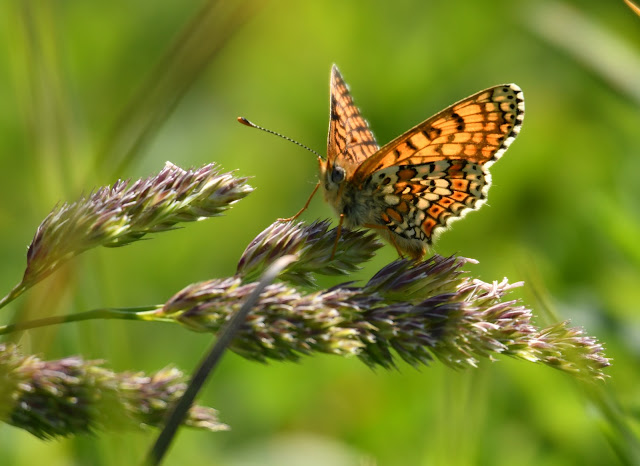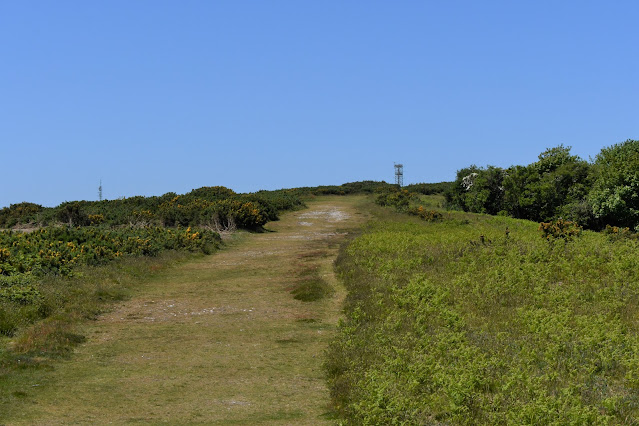The Isle of Wight sits opposite us, separated by 5 miles of salty water called The Solent.
If there were an adjoining direct road, I'm sure I would visit more often, but then I think the island wouldn't have such a charm if it had that immediate access. It would have been spoilt long ago if it had, and having to take time to reach it just adds to the adventure.
The island remains a step behind the mainland as though being just out of sync and so retains a unique charm which is like stepping back in time. My hope is that it's character remains unchanged but then change is ever constant. Hopefully it will always stay unique.
We visit a few times every year. Either for lunch at Ryde, a weeks holiday or a day out discovering it's natural history.
This story is based around the latter.
I usually spend a day in May on the trail of a butterfly that is almost impossible to see on the mainland. This is the focus of a wonderful day out walking around the southern part of the 'Wight' around a place called Ventnor.
Due to the constraints of travelling with ease over the past couple of years I haven't had the opportunity to visit one of my favourite haunts with impunity, but at last it was time, and on this occasion my friend Chris came along. He had been wanting to visit for years and now the stars had aligned.
One of the best ways - also the quickest and most exciting - is to get the only scheduled hovercraft service in the world from Southsea to Ryde. Literally like flying on a cushion of air, it reminds me of my childhood watching the craft slide down the slipway from Daedalus airfield into the sea. This surreal craft, neither boat nor plane, always fills me with excitement to travel on one. If you look closely in the first picture you can see the hovercraft lined up on the slipway at Ryde,waiting to depart.
It was a perfect morning as we waited on Southsea shore for our flight to arrive from the island. Like a millpond on the sea and pleasantly warm.
Upon our safe arrival on the southern edge of the island via taxi from the hovercraft, we were treated to a crimson wall of valerian at Ventnor.
While not a true naturalised valerian, this thrives on the precipitous chalk slopes that border the English Channel.
Another species that hasn't been here that long ecologically speaking is the fabulous Wall Lizard. Like a larger cousin of our Sand Lizard it has taken hold in the microclimate that the southern side of the Wight allows.
They are native to the channel islands but the small colonies dotted around the UK, especially here in Ventnor are introduced.
They are a saxicolous species, which means they live among rocks and are able to climb vertical surfaces. They are also diurnal, meaning they are active day and night and love southern facing rocks and stone walls.
They can produce up to four broods a year and don't hibernate, often seen basking into December.
They are also very easy to see. It wasn't long after the taxi dropped us off that we had our first encounter among the rocks below Ventnor.
After our fill of the lizards we plodded on toward Wheelers Bay - by way of the coastal path - that has a shroud of greenery clinging to it's chalk cliff contrasting beautifully with the patches of chalk and blue sky reflecting in the sea.
Gladioli thrive along there.
Our main quarry had been sighted briefly near the lizards but I knew we would see many more. In the meantime Common Blue were very much in attendance.
Then one of the reasons for visiting the island showed very well, a Glanville Fritillary
As the sign explains, it is on it's most northerly range in the Isle of Wight, although I know of a small colony in Wiltshire and occasionally migrants do appear along the south coast but not amounting to any viable breeding foothold.
Other butterflies showed well, lit up by the light reflecting off the chalk. This is a Brown Argus.
The Glanvilles' kept coming..
Sometimes allowing very intimate views if you were careful when laying down on the ground as they don't generally perch up high. Getting up afterwards is always a challenge however !
Their underwing pattern is quite exquisite as many Fritillaries are known to possess.
The wild flowers washed across the cliffs, valerian, daisy, trefoil and vetch among many others.
More Common Blue
The precipitous cliffs harboured the occasional Whitethroat which made use of the thick cover to set up territories.
All the while we looked above our heads, there were even more Fritillaries around our feet.
The light against the chalk made them stand out even more. We were in our element..
The island being such a microclimate on the southern side, harbours many species that flourish, such as this Sea Aster or Sea Daisy that is native to North America.
At the end of Wheelers Bay the path ascends into the woodland and past St Boniface Church. The original building dated back to the 11th century but was replaced in 1848 although it looks much older than that.
In the graveyard - that is naturally on a slope given it's position on the cliff - we found a Speckled Wood butterfly flitting around the headstones.
Some beautiful houses dot the landscape as you heave your way up the steep paths and road.
We had reached the main road that serves the coast through the southern part of the Wight.
Time to sit, have some packed lunch, a drink and take a breath. This was only the halfway point, it was still uphill from here. Where was the summit!?
Having refuelled, we crossed the road onto the base of St Boniface Down. We had already discussed our route prior to this and had settled on the easier lower path that circles the steep hill.
Our minds were slightly distracted at the sight of even more Glanville Fritillaries at the foot of the hill. They seemed to be everywhere.
Small Heath. Plenty of these around too.
Now it was decision time. Our male egos threw caution to the wind and decided to climb the steepest path, by steep I mean virtually vertical!
After several breath breaks we finally conquered the summit. Every time I stopped enroute to take a photo, my legs were a little wobbly I must admit. Both from the angle of the hill and my lack of breath.
I know what Sir Edmund Hilary must have felt when he conquered Everest. We did it without oxygen and a sherpa however..!
The views across the southern coast were quite breathtaking from up there - now I know where that meaning originates from.
Just to confirm that I'm not over exaggerating the climb. St. Boniface is the highest point on the island at 241 metres above sea level. That's my excuse which I'm sticking to.
Although I was expecting alpine plants at this level, our first encounter were Red Campion.
Butterfly wise I discovered one of my favourites in the form if a tiny Small Copper. Ironically while I was needing to take a comfort break after the long climb. I had finished by the time I took this picture I hasten to add. Definitely not mid flow.
As we began to descend the down which was nearly as difficult as ascending, I noticed a moth in the grasses. It had unfortunately died but I recognised it as a Cream Spot Tiger Moth.
We were nearing Ventnor once again which looked so close from high above but we still had a way to go to get there. Some stunning views from up in the gods though.
Despite our walk's conclusion close at hand, there were so many distractions still before us.
The steepness of St.Boniface Down certainly made it better to lay down and then get up again which was helpful as we found an area teaming with butterflies.
I've never seen Adonis Blue and Glanville Fritillaries on this part before but here they were and not only in numbers but plenty of mating too.
Male Adonis, apart from it's electric blue hue, can be distinguished from the Common Blue by the black lines that carry through the edge of the wing.
Common Blue
Green Alkanet
Adonis
Glanville Fritillaries mating
Once coupled, they were much easier to get close to.
After our special moment watching the Fritillaries mating we were ready to leave but I noticed a pair of Adonis getting jiggy with it too. We decided to gatecrash their coupling as well. We have no shame..
Our final few metres of the magnificent St Boniface gave up yet another Glanville. A very apt ending to a very special day out walking the Wight.
A last glance up from where we had descended. A short walk into Ventnor with a few minutes in hand before our taxi arrived allowed us a celebratory pint in the local pub and to chew the fat over our successful day.
Then it was back to Ryde to catch the return hovercraft to Southsea.
A day of perfect weather coupled with some special moments watching nature going about it's business and one to treasure.
The title of this post is a lyric taken from the song, La Isla Bonita by Madonna












.JPG)
.JPG)

.JPG)

%20(1)-1.JPG)
.JPG)
.JPG)


.JPG)

.JPG)









.JPG)
.JPG)

.JPG)
.JPG)

.JPG)

.JPG)
.JPG)





.JPG)
.JPG)

.JPG)
.JPG)
.JPG)





.JPG)
.JPG)

.JPG)



.JPG)

.JPG)




.JPG)





.JPG)
.JPG)

.JPG)
.JPG)
.JPG)
.JPG)
.JPG)

.JPG)

.JPG)
.JPG)
.JPG)
.JPG)
.JPG)

.JPG)
